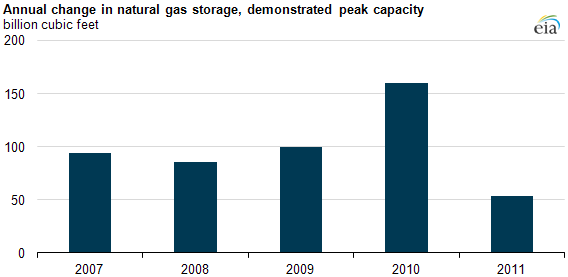
Peak underground natural gas storage capacity up again in 2011

Note: Data are as of April of the report year.
Demand for natural gas, a major fuel for space heating and electricity generation as well as industry, varies significantly by season. For this reason, storage plays an important role in the U.S. natural gas market. Demonstrated peak working natural gas storage capacity is a conservative measure of how much natural gas can be stored; it sums the highest storage level of working gas observed in each field over a 60-month period ending in April of the report year. Storage capacity has grown steadily in recent years. As of April 2011, demonstrated peak capacity was 4,103 billion cubic feet (Bcf), 14% above its level in April 2006.
The demonstrated peak capacity increased less in 2011 than in previous years, growing only 54 Bcf from year-ago levels. The timing of these peaks needs not (and often does not) coincide for different fields. This is largely a result of the high utilization of storage facilities that occurred during the 2010 report year and the limited number of design capacity additions in 2010 and 2011.
Demonstrated peak capacity is a more conservative measure than design capacity. Although design capacity is often certified by Federal or State regulators, design capacities can overstate the amount of gas that can operationally be stored in the facilities. For example, certain facilities in the West region have large design capacities, but have infrastructure constraints that limit actual storage capacity. Other facilities will not reach their design capacities as they are being drawn down to be taken out of service or are used for pipeline load balancing (rather than seasonal storage).
Excluding inactive fields, working natural gas design capacity grew by about 1% (or 57 Bcf) to 4,388 Bcf as of April 2011 from year-ago levels. Although this net increase is higher than last year's, it is less than half of the increase in 2009. Many recent design capacity additions are high-deliverability depleted reservoirs or salt natural gas storage facilities.
Of the three new storage facilities that came online during the report year, two of them are located in the Producing Region and account for about 13 Bcf of the additional design capacity. Moreover, net expansions of existing natural gas salt storage facilities in the Producing Region accounted for nearly a 27-Bcf net increase in working gas design capacity, according to EIA's Natural Gas Annual Respondent Query System.
Tags: capacity, capacity, natural gas, storage, storage